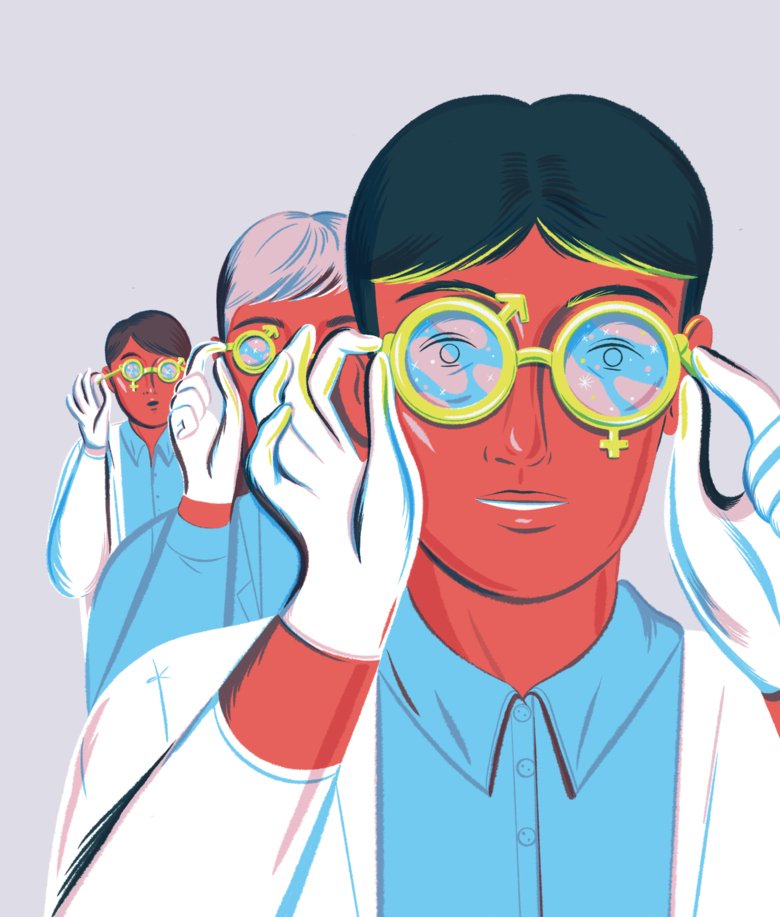Spotlight on sex and gender differences in health
How can we learn more about relationships between sex, gender and health? Part of the solution may be to be more aware of sex at an earlier stage, in experimental basic research.

Text: Sara Nilsson, first published in Swedish in the magazine Medicinsk Vetenskap no 3 2020
COVID-19, the disease caused by the new coronavirus SARS-CoV-2, appears to strike men harder than women; more men are admitted to intensive care units and a higher percentage of men die from the disease. As yet, we do not know the causes of this disparity between the sexes. While more men are overweight, a known risk factor, it is already known that women generally have a stronger immune system; they respond better to vaccines and often have lower mortality from infections. One hypothesis is that the male immune system is less successful at slowing replication of the coronavirus, leading to a more virulent infection.
COVID-19 is far from the only example of a disease that affects men and women differently; for example, depression and autoimmune diseases are more common among women. Men are more likely to suffer from Parkinson’s disease and to commit suicide. Drugs may break down at different rates in women than men, and women in general seek medical care to a greater extent.

Explanations may be found at several levels
“In terms of kidney diseases, my own field of research, we see that women are less likely to undergo a kidney transplant or receive dialysis than men. We don’t really know why this is the case,” says Karolina Kublickiene, MD and docent at the Department of Clinical Science, Intervention and Technology.
Explanations for these differences between the sexes may be found at several levels. While there may be biological factors such as gonadal hormones, anatomy and genetics, the disparities might also be the result of social aspects linked to sex – what we call gender. Sex and gender may also interact. In the case of pain, for example, there are both biological sex differences in the physiology of the pain system and differences in how men and women describe their symptoms.
In many cases, the mechanisms explaining sex differences are also unknown.
“Although recent decades have seen considerable advances in our knowledge of the significance of sex and gender to our health and in various disease processes, there remains room for improvement. We must include these aspects in our research because, the more we understand about them, the more we can improve health for everyone,” says Karolina Kublickiene.
In illustration, she mentions the need to understand why certain diseases are more common in one sex and differences in areas such as disease progression, which symptoms we exhibit, treatment opportunities and how women and men respond to treatment.
International project can improve understanding
Karolina Kublickiene is a member of the international project Gender Outcomes and Well-being Development Group (GOING-FWD), which is studying the significance of sex and gender aspects to cardiovascular disease, diabetes, chronic kidney disease and neurological diseases.
“There is currently no standardised method for measuring gender: that is what we are trying to develop. We know from the results of smaller studies that gender aspects are significant to these diseases but, in order to study this more closely, we need to look at larger data sets,” explains Karolina Kublickiene.
With the aid of register data from five countries, the researchers will investigate which gender aspects – for example, family situation, gender identity, relationships, level of education and occupation – affect metrics related to the patients’ diseases and parameters linked to healthcare costs, such as hospitalisation and readmission. The study is a collaboration between researchers in Sweden, Canada, Spain, Austria and Italy.
“The aim is to understand how sex and gender are linked to the differing outcomes for various patient groups, in order to improve care based on this; for example, sex may affect the individual’s biological risk of developing these chronic diseases, while gender may have an impact through parameters such as career choice and risk behaviours. Sex can affect the individual’s biological reaction to a drug or therapy, while gender may affect their ability to follow a treatment plan or maintain a healthy lifestyle, which in turn affects the disease. It is a matter of understanding more about this so that we can move closer to individualised treatment,” says Karolina Kublickiene.

Sex analysis is often lacking in basic research
Naturally, sex is generally among the variables included in epidemiological studies. In clinical trials too there is now an understanding of the importance of including both sexes and analysing the results based on sex, even if in practice this is not always done to a satisfactory extent. However, according to Tamsin Lindström – coordinator at Karolinska Institutet’s Grants Office who advises on research funding – when it comes to basic and preclinical research, to a large degree sex analysis is lacking.
One explanation is that researchers have largely relied on male laboratory animals, either in the belief that there is no great difference between the sexes or that hormone fluctuations in females may confound measurements.
“It is becoming increasingly obvious that there are sex differences, not only in the area of reproduction, and that, even if hormonal fluctuations create variability among female mice, this is no greater than the variability among males. Of course, depending on what you are studying, there will be cases in which you need to take such hormonal variability into account, but there are several ways to do so,” she says.
The important thing is to design studies and analyse results in a manner that allows the researcher to identify sex differences in the material they are studying, where such differences exist.
This may, for example, mean as far as possible studying cells from both men and women or males and females, or laboratory animals of both sexes – in both control groups and test groups – and then separating the results by sex to see if this reveals any differences hidden in the combined data. A challenge here can be that commercial cell lines often originate from only one sex or have lost their sexual characteristics.

May be significant for treatment
Tamsin Lindström points out that, by including sex as a variable in the early stages of research, it is possible to identify important disease mechanisms that may eventually impact on diagnosis and treatment. As an example, she mentions pain as a field of research where increasing the study of female animals has uncovered mechanisms for how pain processes differ between the sexes at molecular, genetic and cellular level. The same applies to multiple sclerosis, which although more common among women tends to have a more severe disease progression in men. By studying animal models of both sexes, researchers have identified differences in how the disease develops that may be significant to how it can be treated.
The sex aspect is also important if research results are to be reproducible by other research groups – an important criterion for research quality. So far, information on the sex of the animals or cells used has been missing from many studies, making life difficult for anyone seeking to build on the results.
Of course, including a further sex in the research may mean that the work takes longer and costs more, as it may require additional experiments to reveal sex differences.
“Indeed, it may require more money, but some research funders allocate extra funds for it and, hopefully, others will follow suit because, by including sex as a biological variable, we improve the reproducibility and quality of research, as well as the chances of successfully taking the results beyond preclinical research,” says Tamsin Lindström.
These days, research funders are increasingly calling for the integration of sex and gender aspects into research; for example, from 2020, researchers applying for grants from the Swedish Research Council, Sweden’s largest state funder of research, must state whether sex and gender perspectives are relevant to the planned research and, if so, how the study will be planned to take account of these perspectives, or why the researchers have chosen not to do so. Similar demands are being made by research funders in the United States, Canada and Germany, as well as the European Commission. The same applies to a number of scientific journals.
Some researchers believe that such demands have become excessive and that it is difficult to draw conclusions regarding women’s and men’s health based on studies conducted on female and male animals or cells taken from them. They also question why consideration is being demanded of sex and gender and not of other factors that affect outcomes: age, for example.
“Research funders are also beginning to introduce requirements for greater consideration of age; however, that does not diminish the importance of considering sex,” says Tamsin Lindström.
And, according to Karolina Kublickiene, the importance of giving due consideration to sex aspects outweighs any possible downside.
“The cost may be higher at the time but the research must be to everyone’s benefit. If you conduct research related to people’s health, you must consider all relevant aspects that may reflect health,” she says.
What are sex and gender?
Sex is the biological characteristic that divides sexually reproducing organisms, generally into male and female. Sex is defined by the set of chromosomes, gonads and physical characteristics that distinguish the sexes. Some people are born with variants or combinations of these characteristics. It is also possible to have a gender identity that diverges from the legal sex assigned at birth or to identify oneself outside traditional gender categories, or indeed not to identify oneself with a gender at all.
Cells have either two X chromosomes (female) or one X and one Y chromosome (male), which gives rise to sex differences when individual cells are studied. Genes on the Y chromosome are solely expressed in the male and many of them have no equivalent in females. The X chromosome is larger than the Y chromosome and contains considerably more genes, over 1,600.
Gender is the state of being male or female in relation to the social and cultural processes that create expectations and norms based on sex.
Exampels of sex and gender differences in health
 Photo: Getty Images
Photo: Getty ImagesImportant to be aware of sex differences in cardiovascular health
There are sex differences associated with most types of cardiovascular disease. For instance, the symptoms of heart attack may be different for women and men.
 Photo: Pixabay CC0
Photo: Pixabay CC0Obvious sex differences in mental health
There are many mental disorders that affect the sexes to different degrees. Depression and anxiety are two examples that are more common in women, while men are more likely to be diagnosed with addiction.
 Photo: iStockphoto
Photo: iStockphotoMen have a worse prognosis after diagnosed with cancer
Men are at greater risk of developing 34 or the 39 forms of cancer that affect both sexes and have a worse prognosis in 27 of the 39, a doctoral thesis shows.
Tips for scientists
Learn how to address the sex-and-gender dimension of your research — and why it's important to do so!
